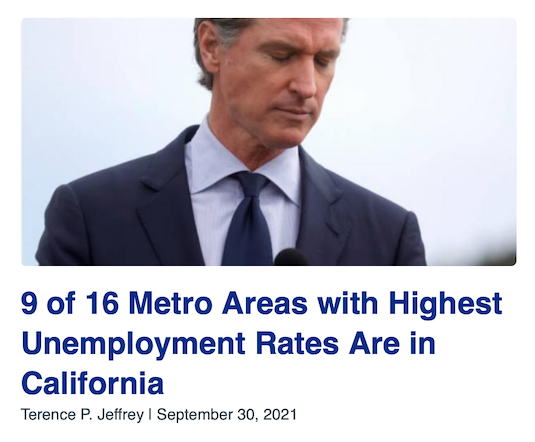CNSNews.com editor Terry Jeffrey intoned in a Sept. 30 article:
Nine of the sixteen U.S. metropolitan statistical areas with the highest August unemployment rates, as ranked this week by the Bureau of Labor Statistics, were in California.
The El Centro metropolitan area, which sits in Imperial County, California, just north of Mexicali, Mexico, led the nation’s 389 metropolitan areas in August with an unemployment rate of 19.4 percent, according to BLS.
That compared to a national unemployment rate for August of just 5.3 percent.
It’s unclear why Jeffrey wrote this article, beyond a quick and dirty shot at California — all he does is recite BLS statistics. An intern could have done that. He made no effort to investigate why these areas have high unemployment; perhaps his goal is to suggest that Californians are lazy bums. So he’s not going to tell you that the El Centro region had a poor economy before the pandemic (and under President Trump). An actual news outlet reported in 2019:
While the United States is enjoying the healthiest job market in half a century, the metropolitan El Centro area has what the U.S. Labor Department says is an unemployment rate of 16.2%, the highest in the nation. By comparison, the rate for the country as a whole is 3.6%.
[…]Many of the jobs here are agricultural: The Imperial Valley is home to thousands of acres of farms that grow cauliflower, potatoes and spinach and require a large seasonal workforce. Some of the farmworkers live here; many others cross the border from Mexico a few miles away to work every day.
Once they become too old to work in the fields, however, few jobs are available other than retail and fast food.
[…]“Our economy is not diversified. It’s a very narrow economy. It’s either farm or government or teaching or low-income, with a few other exceptions,” says Sara Griffen, executive director of the Imperial Valley Food Bank.
Jeffrey went on to wrote that “The Yuma metro area, which sits on the Mexican border in southwest Arizona, had the nation’s second-highest unemployment rate this August. It was 18.2 percent.” Again, Jeffrey couldn’t be bothered to explain why. but as it turns out, Yuma’s economy is much like El Centro’s — impoverished, undiversified, overly dependent on farming, and has been that way for years.
But telling readers that would have required doing actual research and reporting. Jeffrey just wanted to perform stenography for a lazy, partisan shot. It doesn’t inspire much confidence in CNS’ brand of journalism.
